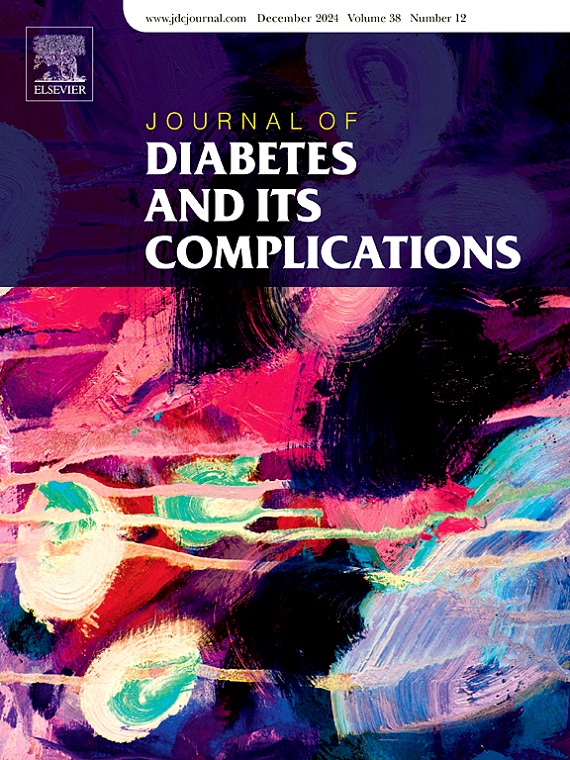Technosphere insulin in the treatment of Type 1 diabetes mellitus: A systematic review and meta-analysis
IF 3.1
3区 医学
Q3 ENDOCRINOLOGY & METABOLISM
引用次数: 0
Abstract
Aims
Conduct a systematic review and meta-analysis comparing Technosphere Insulin and traditional ultra-rapid insulin in T1DM.
Methods
Researchers conducted a systematic search on databases to identify randomized controlled trials (RCTs) comparing two insulin regimens—TI and RAI —in patients with type 1 diabetes mellitus (T1DM). The outcomes of interest included changes in HbA1c levels, body weight, and rates of overall and severe hypoglycemia.
Results
Four RCTs were included. There was no significant difference between groups on change in HbA1c (MD 0.04; 95 % CI −0.19–0.27; p = 0.74; I2 = 0 %). In terms of body weight change, the TI group exhibited significantly less (MD −1.05; 95 % CI −1.63 to −0.46; p = 0.0005; I2 = 0 %) compared to the RAI group. Adverse events such as overall hypoglycemia (RR −0.97; 95 % CI 0.94–1.01; p = 0.24; I2 = 26 %) and severe hypoglycemia (RR 0.63; 95 % CI 0.46–0.87; p = 0.005; I2 = 0 %), were significantly more frequent in the RAI group.
Conclusions
The use of Technosphere Insulin (TI) in T1DM patients did not show a difference in HbA1c, suggesting that TI may offer advantages in weight stability and a lower incidence of hypoglycemic events compared to rapid-acting insulin (RAI).
Technosphere胰岛素治疗1型糖尿病:系统回顾和荟萃分析
目的对技术圈胰岛素和传统超快速胰岛素治疗T1DM进行系统综述和荟萃分析。方法研究人员对数据库进行了系统检索,以确定比较两种胰岛素方案(ti和RAI)在1型糖尿病(T1DM)患者中的应用的随机对照试验(rct)。研究结果包括HbA1c水平、体重、总体低血糖和严重低血糖发生率的变化。结果共纳入4项随机对照试验。两组间HbA1c变化无显著差异(MD 0.04;95% ci - 0.19-0.27;p = 0.74;i2 = 0%)。在体重变化方面,TI组表现出显著减少(MD - 1.05;95% CI为- 1.63 ~ - 0.46;p = 0.0005;I2 = 0%)与RAI组比较。不良事件,如整体低血糖(RR - 0.97;95% ci 0.94-1.01;p = 0.24;I2 = 26%)和严重低血糖(RR 0.63;95% ci 0.46-0.87;p = 0.005;I2 = 0%),在RAI组中更为常见。结论在T1DM患者中使用Technosphere胰岛素(TI)对HbA1c没有影响,这表明与速效胰岛素(RAI)相比,TI在体重稳定和低血糖事件发生率方面可能具有优势。
本文章由计算机程序翻译,如有差异,请以英文原文为准。
求助全文
约1分钟内获得全文
求助全文
来源期刊

Journal of diabetes and its complications
医学-内分泌学与代谢
CiteScore
5.90
自引率
3.30%
发文量
153
审稿时长
16 days
期刊介绍:
Journal of Diabetes and Its Complications (JDC) is a journal for health care practitioners and researchers, that publishes original research about the pathogenesis, diagnosis and management of diabetes mellitus and its complications. JDC also publishes articles on physiological and molecular aspects of glucose homeostasis.
The primary purpose of JDC is to act as a source of information usable by diabetes practitioners and researchers to increase their knowledge about mechanisms of diabetes and complications development, and promote better management of people with diabetes who are at risk for those complications.
Manuscripts submitted to JDC can report any aspect of basic, translational or clinical research as well as epidemiology. Topics can range broadly from early prediabetes to late-stage complicated diabetes. Topics relevant to basic/translational reports include pancreatic islet dysfunction and insulin resistance, altered adipose tissue function in diabetes, altered neuronal control of glucose homeostasis and mechanisms of drug action. Topics relevant to diabetic complications include diabetic retinopathy, neuropathy and nephropathy; peripheral vascular disease and coronary heart disease; gastrointestinal disorders, renal failure and impotence; and hypertension and hyperlipidemia.
 求助内容:
求助内容: 应助结果提醒方式:
应助结果提醒方式:


